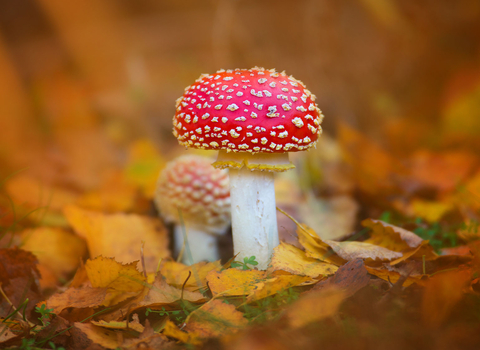Join the Surrey Species Search this autumn!
Through our new pilot project, we're asking people to get outside and keep an eye out for five key species this autumn.
We’re introducing local people to the wonders of wildlife by asking them to look for and record the presence of five key species which typify the range of Surrey’s wildlife - but could disappear if nature’s decline continues.
By going on a Surrey Species Search in your garden or a local community space such as a woodland, playing field or churchyard, you might spot Redwing, Rowan, Muntjac deer, Fly Agaric mushrooms and House Spiders!
By using our specially-designed app, or just uploading records via our web form, you can record and identify these species and report their numbers and locations. The data on species sightings in Surrey will be fed to the Surrey Biodiversity Information Centre (SBIC), a vital body which enables conservationists to understand the changing distribution and abundance of native plants and animals and formulate conservation strategies for them.
Getting started & using the app
You can either submit your records by opening the form on a web browser, or you can download the ArcGIS Survey123 app from the App Store and open the form through the app.*
*If you participated in Five2Find previously, you can access the new species search by opening the ArcGIS Survey 123 app on your device, clicking on the survey, and allowing it to update when prompted.
Option 1: Use the ArcGIS Survey123 app
Step 1: First click the relevant 'download' link below, then open the ArcGIS app once it has finished installing via your device's app store. Next, click the 'Continue without signing in' button within the app. To fully record your findings, you will need to allow the app access to Location Services and the Camera.
Download ArcGIS Survey123 on Android
Download ArcGIS Survey123 on IOS
Step 2: Return to this webpage on your device and click the orange 'Install Five2Find' button below - this will open a new browser window.
Step 3: Click the green 'Open the survey' button.
Step 4: Return to the ArcGIS Survey123 app - Five2Find should begin installation.
Step 5: Watch our short video to find out more, and then begin your search!
Option 2: Use your browser
Step 1: Click the orange 'Open Five2Find' button below - this will open a new browser window.
Step 2: Watch our short video to find out more, and then begin your search!
Why is species recording important?
Over time, the information gathered through Surrey Species Searches will help improve, protect or connect the local green spaces that are most important for wildlife. Surrey Wildlife Trust works with local people and communities across the county to help them reap the benefits of learning about, creating, and caring for wild places – from window boxes and gardens to local parks, playgrounds and nature reserves.
Learn all about the species you’ll be spotting below...
Redwing
Redwing (https://www.youtube.com/watch?v=pI1aOVE2_lM)
© Mike Sims North Norfolk Nature
A small and sociable member of the thrush family, around one million Redwings start to arrive from their breeding grounds in Scandinavia in the autumn, hoping to take advantage of the plentiful berries and worms to be found across the UK’s farmland, hedgerows, parks and large gardens.
Identifying Redwings
The Redwing is dark brown above and white below, with a black-streaked breast and distinctive orangey-red flanks and underwing, which the similar Song Thrush lacks. It has a very smart face pattern, with a white eyebrow stripe and dark brown cheeks.
Where to see Redwings
Redwings arrive in the UK in October. They’ll range widely across parks, gardens and hedgerows in search of berries, before departing in April.
Muntjac
The UK’s smallest resident deer species, these cute, Labrador-sized creatures were privately introduced to Bedfordshire in the last century and have now become widespread. Solitary by nature, their small size and low profile means they can exist quite close to human habitation – and often wreak havoc on vegetable patches!
Identifying Muntjac
A very small, stocky deer, the Muntjac deer is about the same size as a medium dog. It is gingery-brown, with a pale underside, darker stripes on its face, and small, single-pointed antlers.
Where to see Muntjac
Muntjac is now a common animal across southeast England and can be found in woodland, parkland and even gardens. They eat the shoots from shrubs, as well as woodland herbs and brambles.
Rowan
Rowan (https://www.youtube.com/watch?v=pHoCsCsxExA)
© Woodland Trust
A small, slender native tree which and can live for up to 200 years, bright red Rowan berries supply crucial autumn sustenance for many species of birds, including Blackbirds, Redwings and Waxwings. By eating the berries, these birds help the tree to disperse its seeds.
Identifying Rowan
Rowan has Ash-like leaves (15 leaflets arranged in pairs) with toothed edges. It displays five-petalled, creamy-white flowers in clusters, followed by masses of red berries.
Where to see Rowan
Rowan can be found in local parks, heaths and woodland edges. Rowan is also known as 'Mountain Ash' because of the Ash-like shape of its leaves and its preference for upland areas - it is often seen standing as a lone tree in a dramatic, windswept landscape.
Fly Agaric
Fly Agaric (https://www.youtube.com/watch?v=r9s0hTmbZho)
© Devon Wildlife Trust
One of the most iconic fungi species, the Fly Agaric is the classic red-and-white toadstool of fairy tales and a truly magical sight amongst the autumnal leaf litter.
Identifying Fly Agaric
The distinctive mushrooms have a red cap, either flat or rounded, often with a scattering of white spots or warts, and a white stem. The gills, beneath the cap, are free of the stem.
Where to see Fly Agaric
The colourful fruiting bodies of Fly Agaric can usually be seen between late summer and early winter, typically growing beneath birch trees or pines and spruces. The mycelium of Fly Agaric often forms a symbiotic relationship with the trees around it, wrapping around the roots and supplying them with nutrients taken from the soil. In exchange, the fungus receives sugars produced by the trees.
Giant House Spider
Giant House Spider (https://www.youtube.com/watch?v=oLNHdssIj_I)
© Spider Savage
The Giant House Spider is the largest of many similar species of spider which take advantage of our warm, dry homes to find shelter, food and a place to nest. There’s nothing romantic about family life with these guys though: males stay with their chosen females for some weeks, mating numerous times until eventually they are eaten by their rapacious partners. Don’t be afraid though – these guys can’t hurt people!
Identifying Giant House Spiders
The Giant House Spider is a species of house spider. As a group, their long-legs, dark hairy bodies and preference for houses and buildings make them unmistakeable.
Where to see Giant House Spiders
House Spiders tend to keep themselves to themselves, preferring dark corners where they can live in peace. But in late summer and early autumn the males reach maturity and seek out a female to woo, which is when we often see them in our homes.
Please use the Five2Find app or the web form to report sightings of Fly Agaric, Redwings, Muntjac, Rowan and Giant House Spiders.
To report sightings of any native species not listed, please contact Surrey Biodiversity Information Centre (SBIC) at surreybic@surreywt.org.uk.
Find out more about the simply actions you can take to support nature's recovery at home:





